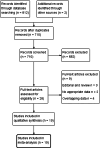Robot-assisted surgery versus conventional laparoscopic surgery for endometrial cancer: a systematic review and meta-analysis
- PMID: 27217038
- PMCID: PMC11818985
- DOI: 10.1007/s00432-016-2180-x
Robot-assisted surgery versus conventional laparoscopic surgery for endometrial cancer: a systematic review and meta-analysis
Abstract
Purpose: To compare perioperative outcomes between robot-assisted surgery (RAS) and conventional laparoscopic surgery (CLS) for the treatment of endometrial cancer by conducting a meta-analysis.
Methods: We searched the Cochrane Central Register of Controlled Trials, PubMed, and EMBASE up to January 8, 2016. Studies clearly documenting a comparison between RAS and CLS for patients with endometrial cancer were included. The perioperative outcomes of interest included intraoperative visceral injuries, postoperative complications, operation time, estimated blood loss (EBL), blood transfusion, total lymph nodes harvested (TLNH), conversion to laparotomy, and length of hospital stay. The weighted mean difference (WMD) and odds ratio (OR) were pooled with either a fixed-effects or a random-effects model.
Results: A total of 19 studies were included in the analysis, involving 3056 patients. The pooled analysis showed that RAS was associated with lower EBL (WMD -77.65; 95 % confidence interval [CI] -105.58 to -49.72), lower conversion rate (OR 0.29; 95 % CI 0.18-0.46), and shorter hospital stay (WMD -0.48; 95 % CI -0.70 to -0.26) compared to CLS. The incidence of intraoperative visceral injuries, operation time, transfusion rate, and TLNH showed no significant differences between RAS and CLS.
Conclusions: RAS is a feasible and effective surgical approach that may be superior to CLS for the treatment of endometrial cancer, with lower EBL and lower conversion rate. Further prospective randomized trials are required to validate our findings.
Keywords: Conventional laparoscopic surgery; Endometrial cancer; Meta-analysis; Perioperative outcomes; Robot-assisted surgery.
Conflict of interest statement
The authors declare that they have no conflict of interest.
Figures









Similar articles
-
Laparoscopy versus laparotomy for the management of early stage endometrial cancer.Cochrane Database Syst Rev. 2012 Sep 12;(9):CD006655. doi: 10.1002/14651858.CD006655.pub2. Cochrane Database Syst Rev. 2012. Update in: Cochrane Database Syst Rev. 2018 Oct 31;10:CD006655. doi: 10.1002/14651858.CD006655.pub3. PMID: 22972096 Updated.
-
Comparative safety and effectiveness of robot-assisted laparoscopic hysterectomy versus conventional laparoscopy and laparotomy for endometrial cancer: A systematic review and meta-analysis.Eur J Surg Oncol. 2016 Sep;42(9):1303-14. doi: 10.1016/j.ejso.2016.06.400. Epub 2016 Jun 29. Eur J Surg Oncol. 2016. PMID: 27439723
-
Laparoscopic treatment of endometrial cancer: systematic review.J Minim Invasive Gynecol. 2013 Jul-Aug;20(4):413-23. doi: 10.1016/j.jmig.2013.01.005. Epub 2013 Mar 15. J Minim Invasive Gynecol. 2013. PMID: 23506718
-
Surgical approach to hysterectomy for benign gynaecological disease.Cochrane Database Syst Rev. 2015 Aug 12;2015(8):CD003677. doi: 10.1002/14651858.CD003677.pub5. Cochrane Database Syst Rev. 2015. Update in: Cochrane Database Syst Rev. 2023 Aug 29;8:CD003677. doi: 10.1002/14651858.CD003677.pub6. PMID: 26264829 Free PMC article. Updated.
-
Surgical approach to hysterectomy for benign gynaecological disease.Cochrane Database Syst Rev. 2023 Aug 29;8(8):CD003677. doi: 10.1002/14651858.CD003677.pub6. Cochrane Database Syst Rev. 2023. PMID: 37642285 Free PMC article.
Cited by
-
Robotic Versus Laparoscopic Pancreaticoduodenectomy: An Up-To-Date System Review and Meta-Analysis.Front Oncol. 2022 Feb 25;12:834382. doi: 10.3389/fonc.2022.834382. eCollection 2022. Front Oncol. 2022. PMID: 35280811 Free PMC article.
-
National Trends in Robotic Pancreas Surgery.J Gastrointest Surg. 2021 Apr;25(4):983-990. doi: 10.1007/s11605-020-04591-w. Epub 2020 Apr 20. J Gastrointest Surg. 2021. PMID: 32314230
-
Detailed cost of robotic-assisted surgery in the Australian public health sector: from implementation to a multi-specialty caseload.BMC Health Serv Res. 2021 Feb 1;21(1):108. doi: 10.1186/s12913-021-06105-z. BMC Health Serv Res. 2021. PMID: 33522941 Free PMC article.
-
A comparison of operative outcomes between standard and robotic laparoscopic surgery for endometrial cancer: A systematic review and meta-analysis.Int J Med Robot. 2017 Dec;13(4):e1851. doi: 10.1002/rcs.1851. Epub 2017 Aug 1. Int J Med Robot. 2017. PMID: 28762635 Free PMC article.
-
Validity evidence for procedural competency in virtual reality robotic simulation, establishing a credible pass/fail standard for the vaginal cuff closure procedure.Surg Endosc. 2018 Oct;32(10):4200-4208. doi: 10.1007/s00464-018-6165-5. Epub 2018 Mar 30. Surg Endosc. 2018. PMID: 29603003
References
-
- Bell MC, Torgerson J, Seshadri-Kreaden U, Suttle AW, Hunt S (2008) Comparison of outcomes and cost for endometrial cancer staging via traditional laparotomy, standard laparoscopy and robotic techniques. Gynecol Oncol 111(3):407–411. doi:10.1016/j.ygyno.2008.08.022 - PubMed
-
- Boggess JF, Gehrig PA, Cantrell L, Shafer A, Ridgway M, Skinner EN et al (2008) A comparative study of 3 surgical methods for hysterectomy with staging for endometrial cancer: robotic assistance, laparoscopy, laparotomy. Am J Obstet Gynecol 199(4):360.e1-9. doi:10.1016/j.ajog.2008.08.012 - PubMed
-
- Cardenas-Goicoechea J, Adams S, Bhat SB, Randall TC (2010) Surgical outcomes of robotic-assisted surgical staging for endometrial cancer are equivalent to traditional laparoscopic staging at a minimally invasive surgical center. Gynecol Oncol 117(2):224–228. doi:10.1016/j.ygyno.2010.01.009 - PMC - PubMed
-
- Cardenas-Goicoechea J, Shepherd A, Momeni M, Mandeli J, Chuang L, Gretz H et al (2014) Survival analysis of robotic versus traditional laparoscopic surgical staging for endometrial cancer. Am J Obstet Gynecol 210(2):160.e1–160.e11. doi:10.1016/j.ajog.2013.10.871 - PubMed
Publication types
MeSH terms
LinkOut - more resources
Full Text Sources
Other Literature Sources

